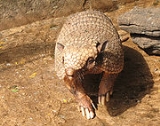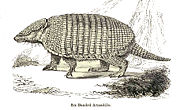
Six-banded Armadillo
Encyclopedia
The Six-banded Armadillo (Euphractus sexcinctus), also known as the Yellow Armadillo, is a species
of armadillo
from South America
. It is found in Argentina
, Bolivia
, Brazil
, Uruguay
, Paraguay
and isolated populations in Suriname
(there known as Siksi-banti kapasi). Its body is usually yellowish in color, sometimes tan or light reddish-brown. It belongs to the monotypic
genus Euphractus.
 It is a solitary terrestrial animal, living in many habitat
It is a solitary terrestrial animal, living in many habitat
s from rainforest
to grassland
, but mainly found on open areas, such as cerrado
plains. It is omnivorous, feeding on a wide range of plant and animal matter. It shelters in a den underground. Unlike most species of armadillo, the six-banded armadillo is mostly diurnal
rather than nocturnal.
Species
In biology, a species is one of the basic units of biological classification and a taxonomic rank. A species is often defined as a group of organisms capable of interbreeding and producing fertile offspring. While in many cases this definition is adequate, more precise or differing measures are...
of armadillo
Armadillo
Armadillos are New World placental mammals, known for having a leathery armor shell. Dasypodidae is the only surviving family in the order Cingulata, part of the superorder Xenarthra along with the anteaters and sloths. The word armadillo is Spanish for "little armored one"...
from South America
South America
South America is a continent situated in the Western Hemisphere, mostly in the Southern Hemisphere, with a relatively small portion in the Northern Hemisphere. The continent is also considered a subcontinent of the Americas. It is bordered on the west by the Pacific Ocean and on the north and east...
. It is found in Argentina
Argentina
Argentina , officially the Argentine Republic , is the second largest country in South America by land area, after Brazil. It is constituted as a federation of 23 provinces and an autonomous city, Buenos Aires...
, Bolivia
Bolivia
Bolivia officially known as Plurinational State of Bolivia , is a landlocked country in central South America. It is the poorest country in South America...
, Brazil
Brazil
Brazil , officially the Federative Republic of Brazil , is the largest country in South America. It is the world's fifth largest country, both by geographical area and by population with over 192 million people...
, Uruguay
Uruguay
Uruguay ,officially the Oriental Republic of Uruguay,sometimes the Eastern Republic of Uruguay; ) is a country in the southeastern part of South America. It is home to some 3.5 million people, of whom 1.8 million live in the capital Montevideo and its metropolitan area...
, Paraguay
Paraguay
Paraguay , officially the Republic of Paraguay , is a landlocked country in South America. It is bordered by Argentina to the south and southwest, Brazil to the east and northeast, and Bolivia to the northwest. Paraguay lies on both banks of the Paraguay River, which runs through the center of the...
and isolated populations in Suriname
Suriname
Suriname , officially the Republic of Suriname , is a country in northern South America. It borders French Guiana to the east, Guyana to the west, Brazil to the south, and on the north by the Atlantic Ocean. Suriname was a former colony of the British and of the Dutch, and was previously known as...
(there known as Siksi-banti kapasi). Its body is usually yellowish in color, sometimes tan or light reddish-brown. It belongs to the monotypic
Monotypic
In biology, a monotypic taxon is a taxonomic group with only one biological type. The term's usage differs slightly between botany and zoology. The term monotypic has a separate use in conservation biology, monotypic habitat, regarding species habitat conversion eliminating biodiversity and...
genus Euphractus.

Habitat
* Habitat , a place where a species lives and grows*Human habitat, a place where humans live, work or play** Space habitat, a space station intended as a permanent settlement...
s from rainforest
Rainforest
Rainforests are forests characterized by high rainfall, with definitions based on a minimum normal annual rainfall of 1750-2000 mm...
to grassland
Grassland
Grasslands are areas where the vegetation is dominated by grasses and other herbaceous plants . However, sedge and rush families can also be found. Grasslands occur naturally on all continents except Antarctica...
, but mainly found on open areas, such as cerrado
Cerrado
The Cerrado, is a vast tropical savanna ecoregion of Brazil, particularly in the states of Gioas and Minas Gerais...
plains. It is omnivorous, feeding on a wide range of plant and animal matter. It shelters in a den underground. Unlike most species of armadillo, the six-banded armadillo is mostly diurnal
Diurnal animal
Diurnality is a plant or animal behavior characterized by activity during the day and sleeping at night.-In animals:Animals that are not diurnal might be nocturnal or crepuscular . Many animal species are diurnal, including many mammals, insects, reptiles and birds...
rather than nocturnal.
Subspecies
- Euphractus sexcinctus boliviae ThomasOldfield ThomasOldfield Thomas FRS was a British zoologist.Thomas worked at the Natural History Museum on mammals, describing about 2,000 new species and sub-species for the first time. He was appointed to the Museum Secretary's office in 1876, transferring to the Zoological Department in 1878...
, 1907 - Euphractus sexcinctus flavimanus DesmarestAnselme Gaëtan DesmarestAnselme Gaëtan Desmarest was a French zoologist and author. He was the son of Nicolas Desmarest and father of Anselme Sébastien Léon Desmarest...
, 1804 - Euphractus sexcinctus setosus WiedPrince Maximilian of Wied-NeuwiedPrince Alexander Philipp Maximilian zu Wied-Neuwied was a German explorer, ethnologist and naturalist....
, 1826 - Euphractus sexcinctus tucumanus Thomas, 1911

